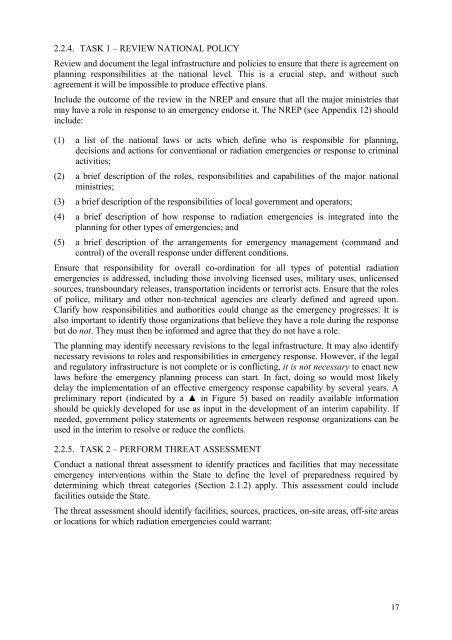epr-method (2003) - IAEA Publications - International Atomic Energy ...
epr-method (2003) - IAEA Publications - International Atomic Energy ...
epr-method (2003) - IAEA Publications - International Atomic Energy ...
You also want an ePaper? Increase the reach of your titles
YUMPU automatically turns print PDFs into web optimized ePapers that Google loves.
2.2.4. TASK 1 – REVIEW NATIONAL POLICY<br />
Review and document the legal infrastructure and policies to ensure that there is agreement on<br />
planning responsibilities at the national level. This is a crucial step, and without such<br />
agreement it will be impossible to produce effective plans.<br />
Include the outcome of the review in the NREP and ensure that all the major ministries that<br />
may have a role in response to an emergency endorse it. The NREP (see Appendix 12) should<br />
include:<br />
(1) a list of the national laws or acts which define who is responsible for planning,<br />
decisions and actions for conventional or radiation emergencies or response to criminal<br />
activities;<br />
(2) a brief description of the roles, responsibilities and capabilities of the major national<br />
ministries;<br />
(3) a brief description of the responsibilities of local government and operators;<br />
(4) a brief description of how response to radiation emergencies is integrated into the<br />
planning for other types of emergencies; and<br />
(5) a brief description of the arrangements for emergency management (command and<br />
control) of the overall response under different conditions.<br />
Ensure that responsibility for overall co-ordination for all types of potential radiation<br />
emergencies is addressed, including those involving licensed uses, military uses, unlicensed<br />
sources, transboundary releases, transportation incidents or terrorist acts. Ensure that the roles<br />
of police, military and other non-technical agencies are clearly defined and agreed upon.<br />
Clarify how responsibilities and authorities could change as the emergency progresses. It is<br />
also important to identify those organizations that believe they have a role during the response<br />
but do not. They must then be informed and agree that they do not have a role.<br />
The planning may identify necessary revisions to the legal infrastructure. It may also identify<br />
necessary revisions to roles and responsibilities in emergency response. However, if the legal<br />
and regulatory infrastructure is not complete or is conflicting, it is not necessary to enact new<br />
laws before the emergency planning process can start. In fact, doing so would most likely<br />
delay the implementation of an effective emergency response capability by several years. A<br />
preliminary report (indicated by a in Figure 5) based on readily available information<br />
should be quickly developed for use as input in the development of an interim capability. If<br />
needed, government policy statements or agreements between response organizations can be<br />
used in the interim to resolve or reduce the conflicts.<br />
2.2.5. TASK 2 – PERFORM THREAT ASSESSMENT<br />
Conduct a national threat assessment to identify practices and facilities that may necessitate<br />
emergency interventions within the State to define the level of preparedness required by<br />
determining which threat categories (Section 2.1.2) apply. This assessment could include<br />
facilities outside the State.<br />
The threat assessment should identify facilities, sources, practices, on-site areas, off-site areas<br />
or locations for which radiation emergencies could warrant:<br />
17

















